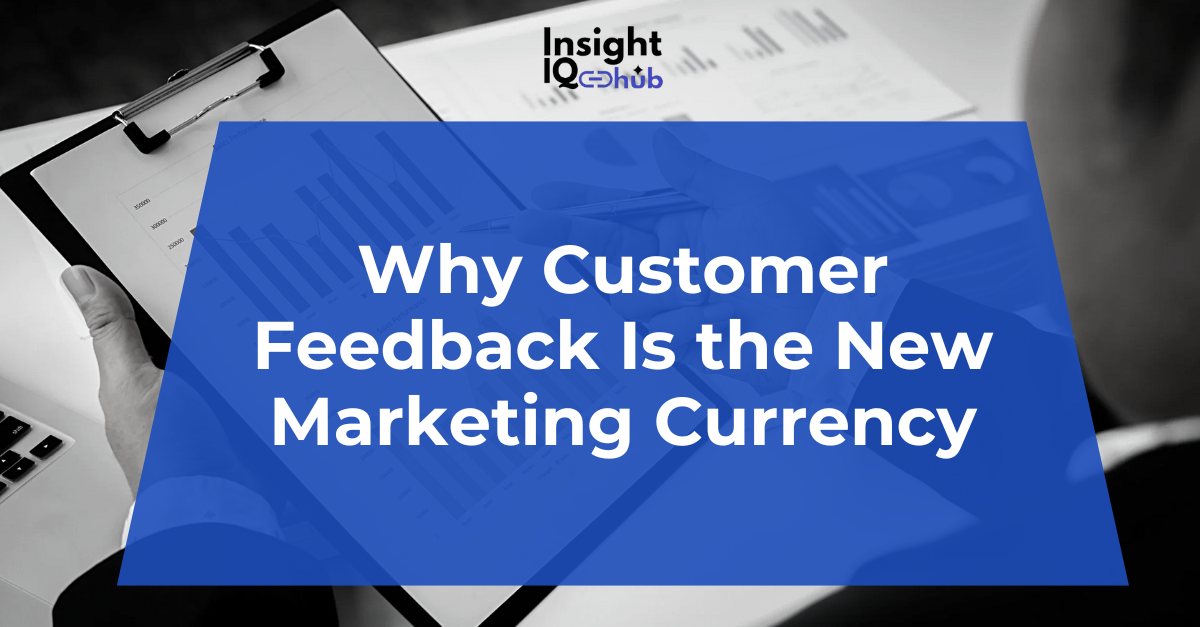In today’s world, your customers don’t just buy your products. They build your reputation. And in a noisy market where ads get skipped, ignored, or blocked, what truly cuts through the clutter is one thing: Customer Feedback.
Every review, every rating, every comment has become a form of currency. The more feedback your business earns and acts on, the stronger your marketing becomes. In this article, you’ll learn why customer feedback is the new marketing currency, how to collect it, and how to turn it into real business growth.
What Does It Mean to Call Customer Feedback “Marketing Currency”?
When we say customer feedback is the new marketing currency, it means that your customers’ voices now hold value—real, measurable value.
Think of it like money you can invest back into your brand. Every positive review is social proof. Every piece of constructive criticism is insight for improvement. Together, they shape your marketing, help you make smarter decisions, and attract new buyers without spending extra on ads.
Unlike paid ads that disappear after a few days, feedback keeps working for you. It builds trust, influences buying decisions, and boosts your credibility. A recent BrightLocal study shows that 98% of people read online reviews before making a purchase, and 49% trust them as much as personal recommendations. That’s not just opinion, it’s marketing power in action.
The Value of Customer Feedback in Marketing
Customer feedback does more than measure satisfaction. It creates value across your marketing funnel. Here’s how:
1. It Builds Trust and Credibility
When customers see genuine feedback from others, they trust your business more. Feedback acts as social proof, reassuring potential buyers that your product or service delivers on its promises.
For example, a barber who shares real client reviews on social media doesn’t need to boast. The clients do the talking. And that’s the most powerful marketing of all.
2. Customer Feedback Fuels Word-of-Mouth Marketing
Every satisfied customer becomes a brand ambassador. Their positive comments spread through word-of-mouth, social media shares, and community referrals.
Encouraging feedback creates a ripple effect. When one person leaves a review, it inspires others to do the same. And when your customers talk about you, your marketing budget stretches further.
3. It Helps You Understand What Works
Customer feedback helps you know what’s working and what needs fixing. You stop guessing and start acting on real data.
For example, if customers say your delivery is slow, you know where to improve. If they praise your customer service, you can highlight that in your promotions. Marketing becomes smarter, not louder.
4. It Reduces Customer Churn and Boosts Loyalty
Acting on feedback tells your customers you care. When people feel heard, they stay loyal.
That means fewer lost customers and more repeat buyers; proof that listening pays off.
READ ALSO: How to Tell When Your Customers Are Unhappy (Even If They Don’t Say It): 5 Silent Red Flags
How to Collect Feedback That Actually Matters
Not all feedback is useful. What matters is how you collect it. Here are simple and effective ways to start:
1. Online Surveys

Surveys help you collect structured opinions. Use tools like Insight IQ Hub to pull short, smart surveys that capture exactly what customers feel about your service or product.
You can ask questions like:
- “What did you enjoy most about our service?”
- “How can we make your experience better?”
Keep it short and personal. People are more likely to respond when they feel their voice matters.
2. Social Media
Social platforms are powerful feedback engines. Ask questions, post polls, and encourage followers to comment.
A small restaurant, for example, can post two new menu options and ask customers to vote. This not only builds engagement but also gives direct insight into what people want before spending money on printing menus or running ads.
3. Product Reviews
If you sell physical products, encourage customers to leave reviews on platforms like Google My Business, Jumia, or Amazon. Respond to every review—good or bad. Your response shows accountability and turns feedback into connection.
4. In-Person or In-App Feedback
If you run a local business, ask for feedback right after service. A simple “How was your experience today?” can spark powerful insights.
For apps or digital services, use in-app surveys or pop-ups to collect instant impressions while the experience is still fresh.
Turning Feedback Into Marketing Assets

Customer feedback isn’t just information, it’s content. And smart marketers know how to use it.
Here are a few creative ways to turn customer voices into marketing fuel:
1. Use Testimonials in Your Ads and Website
Short, authentic quotes from real customers outperform polished brand messages. Showcase them on your homepage, flyers, or social media.
For example:
“Ever since we switched to Insight IQ Hub, our customer satisfaction score improved by 40%!” – Local café owner
That line sells more than any slogan.
2. Create Stories from Feedback
Turn recurring feedback into stories. If customers love your quick response time, share a “behind the scenes” story showing how your team makes it happen. Storytelling humanizes your brand and builds emotional connection.
3. Power Your Emails and Remarketing
Feature reviews and ratings in your newsletters or retargeting campaigns. Seeing positive feedback can nudge past visitors to return and buy.
4. Guide Product and Service Improvements
Feedback also helps refine your marketing offer. When customers tell you what they need, you can adjust your promotions to match their expectations, saving money on campaigns that don’t convert.
READ ALSO: How To Grow Your Business In Nigeria With Customer Feedback
Measuring the ROI of Customer Feedback
To treat feedback like currency, you need to measure its return. Here’s how to track it:
- Conversion Rate Lift: Compare sales before and after displaying reviews or testimonials.
- Customer Retention Rate: Measure how feedback-driven improvements affect loyalty.
- Net Promoter Score (NPS): Track how many customers are likely to recommend your brand.
- Customer Lifetime Value (CLV): Identify if repeat purchase rates increase after acting on feedback.
- Social Engagement: See how feedback content boosts comments, shares, or saves.
When you track these metrics, you begin to see how each piece of feedback adds value over time. Tools like Insight IQ Hub make it easier to visualize this impact through AI-powered dashboards, helping you connect feedback directly to growth.
Local Business Examples
Example 1: The Local Café
A small café in Lagos noticed customers often mentioned “long wait times” on feedback forms. After adjusting their workflow, they promoted the change online using those same customer comments. Within a month, online reviews jumped by 30%, and daily sales increased by 20%.
Customer feedback didn’t just fix a problem. It became their marketing message: “Now faster than ever, because you asked.”
Example 2: The E-Commerce Store
An online clothing store added customer photos and reviews under each product. Conversion rates increased by 18% in three weeks. People trusted real buyers more than polished studio shots.
Feedback turned into visual proof. It built credibility that no advertisement could match.

READ ALSO: How Bad Customer Experience Kills Small Businesses in 2025 (and How To Fix It Fast!)
Common Pitfalls (and How to Avoid Them)
While customer feedback is powerful, there are traps to avoid:
- Collecting too much data without acting on it. Focus on what’s actionable.
- Ignoring negative feedback. Every complaint is a chance to improve.
- Faking or filtering reviews. Authenticity beats perfection every time.
- Feedback fatigue. Don’t overwhelm customers with too many surveys.
The golden rule: always close the loop. If customers take time to share, show them that you listened. A short thank-you message or update can turn critics into loyal fans.
Scaling Customer Feedback as You Grow

As your business expands, feedback collection should scale too. You can:
- Automate surveys with platforms like Insight IQ Hub to collect feedback at every customer touchpoint.
- Set up a feedback dashboard to track patterns in real time.
- Use AI sentiment analysis to spot common emotions behind responses.
- Segment results by location, product, or customer type for deeper insights.
Scaling feedback turns your customers into active collaborators in your growth journey. That’s what the global financial service company, Fiserv, did. You can read their story here.
The Future of Customer Feedback
The future of marketing is transparent, data-driven, and customer-led.
Artificial intelligence now helps businesses understand tone, emotion, and intent behind each review. Real-time feedback is shaping promotions, personalizing experiences, and even predicting customer needs.
Imagine being able to adjust your pricing, offers, or services instantly because feedback told you where the demand was strongest. That’s where tools like Insight IQ Hub are heading, turning raw data into marketing intelligence that moves fast and feels personal.
Conclusion: Listen. Act. Grow.
Customer feedback is more than a survey or a review. It’s the heartbeat of your business. It tells you what your customers love, what frustrates them, and what they expect next.
When you listen and act, you build trust. When you showcase that trust, you attract more customers. That’s why customer feedback isn’t just valuable, it’s marketing currency.
So if you haven’t already, start investing in the voices of your customers. Collect feedback, analyze it, and let it shape how you sell, serve, and grow.
And if you want an easier way to manage and understand all that feedback in one place, try Insight IQ Hub—the smart tool built to help local businesses like yours turn customer feedback into real revenue.




